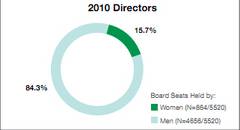I did not think of the very obvious when writing a post yesterday about Jive Software’s new members to its board of directors.

The men Jive chose are all talented, intelligent and well-respected people. They have risen to the top of their fields. But where are the women?
Jive is not an uncommon example. But the lack of women board members does point to a problem that companies need to address. For the companies that do, there could be advantages that they never expected.
Why It Makes Sense to Have More Women Board Members
For reference, German companies have adopted a voluntary initiative due to the poor representation of women in board seats. In 2010 only 2.2% of executive board members at Germany’s 30 Dax companies were women, according to data from DIW, the German Institute for Economic Research, which the Financial Times refers to in its post about the German initiative.
Women held about15% of board seats at Fortune 500 companiesin 2010, according to Catalyst, a nonprofit membership organization that expands opportunities for women in business.

Is it an obvious question to ask why there are so few women board members? Perhaps it is more enlightening to ask why it makes sense to have women on the board.
But first let’s consider some of the reasons why women are absent from board positions.
Rachel Happe writes in a blog post that the the startup world’s go-go-go nature and the resemblance to frat boy culture is an environment where women do not necessarily want to lead. In the same post, Happe writes about the success of women who graduate from women’s colleges, which is evident in their spots on board of directors. The problem is there are so few women graduating from women’s colleges. That seems like it is part of the issue, too.
Judy Rosener wrote a post two years ago that still rings true today. Most CEOs are men. And most do not seek out women for the job. They seek people like themselves. What they need to do is get out there and look.
If they do that, you can bet there will be women in board-of-director roles.
But what are some of the reasons to have women on your board? Rosener distills it down to this:
Good business sense means taking into consideration the following: knowledge of the labor pool; knowledge of new and growing markets; interest in improving corporate governance; and the tracking of revenue and profit, i.e. attention to the bottom line.
Let’s look at each of these reasons.
Labor Pool: Women are more than half of the workforce. Doesn’t it make sense that they should be represented on the board of directors, too? To exclude women from the board can mean that the company may not be seen as a place that welcomes women at all. In turn, that has a direct effect on the company’s competitiveness.
The Market: Women are decision makers. Women have a perspective that can alter the development of a product or a service. They manage the finances in the home. They make the purchases. Put women in executive roles and board positions and you can see how their perspectives may open new markets.
Governance: A woman joining a board of directors can have an effect on the men. They will be less likely to make sexist remarks and jokes. But there is more to this. Rosener writes:
I asked Shirley M. Hufstedler, an experienced corporate board member, how she thinks the presence of women changes a board. Hufstedler served for many years on both the Hewlett-Packard and US West boards, and currently sits on the Harman International Industries board. She said it is her observation that female board members usually understand, better than men, how to appeal to women as consumers and as employees. “Also, because women are acculturated differently from men, they tend to listen more and see problems and solutions differently from their male colleagues.” In many ways this expands and enhances board discussion and deliberation.
Bottom Line: Companies with more women in executive positions tend to have higher profits. She writes:
A study by Roy Adler, a professor at Pepperdine University in Malibu, California, tracked 215 Fortune 500 companies, comparing their financial performance to industry medians. He found that “companies that smash the glass ceiling also enjoy higher profits.” In a recent Harvard Business Review article presenting his findings, Adler showed that “the companies with the highest percentages of female executives delivered earnings far in excess of the median for other large firms in their industries.” The Canadian Conference Board findings support those of Adler. It tracked the financial well being of firms with two or more women on their boards in 1995 to see where they stood six years later. It found that firms with women board members were much more likely than companies with all-male boards to be leaders when ranked by revenue or profit. While these two studies do not a theory make, they suggest there is a relationship between the presence of women on boards and financial performance.
Considering that why would a company not have a women on its board?





















